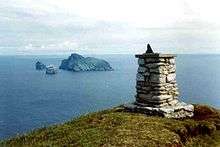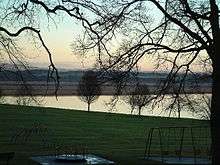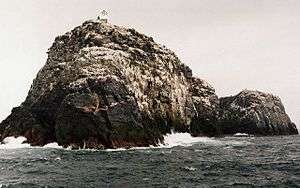List of outlying islands of Scotland

The outlying islands of Scotland incorporate those that are not part of the larger archipelagos and island groups of Scotland and are thus not listed as being part of the Hebrides, the Northern Isles or the Islands of the Forth and Clyde estuaries. None of these islands are currently inhabited and few of them ever were, although Hirta was occupied from the Neolithic age until 1930 and Stroma was permanently occupied until the 1970s and thereafter by lighthouse keepers and their families until 1996.[1][2] Several other outlying islands have lighthouses, none of which are still manned.
In this list, an island is defined as "land that is surrounded by seawater on a daily basis, but not necessarily at all stages of the tide, excluding human devices such as bridges and causeways".[Note 1] A complication relating to membership of this list is that there are various descriptions of the scope of the Hebrides, the large group of islands that lie off Scotland's west coast. The Collins Encyclopedia of Scotland describes the Inner Hebrides as lying "east of The Minch", which would include any and all offshore islands. There are various islands that lie in the sea lochs such as Eilean Bàn and Eilean Donan that might not ordinarily be described as "Hebridean" but no formal definitions exist and for simplicity they are included in the List of Inner Hebrides rather than here.[5][Note 2]
Main islands

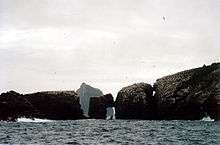
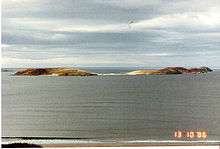
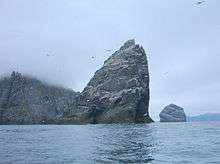

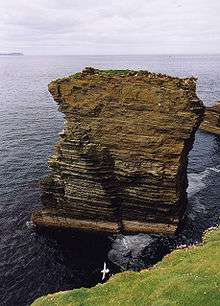
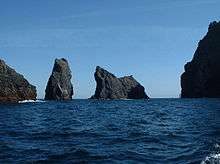
There are several small groupings of outlying islands involved. The most significant of these is the St Kilda archipelago[Note 3] which lies 64 kilometres (40 mi) west-northwest of North Uist and is now a World Heritage Site. It is one of the few to hold joint status for its natural and cultural qualities.[8][Note 4] At 196 metres (643 ft) Stac an Armin is the highest sea stack in the British Isles[10][11][12] and in July 1840, the last great auk seen in the British Isles was captured there.[13]
East of St Kilda are the Flannan Isles, the location of an enduring mystery which occurred in December 1900, when all three lighthouse keepers vanished without trace.[14] Further north and east are the two outliers of Sula Sgeir and North Rona, which have strong cultural links to the Outer Hebrides. North Rona is 71 kilometres (44 mi) north north east of Butt of Lewis and 18 kilometres (11 mi) east of Sula Sgeir. It is the remotest island in the British Isles to have ever been inhabited on a long-term basis. It is also closer than any other part of Scotland to the Faroe Islands. Sule Skerry and Sule Stack lie further east and are administratively part of Orkney.
The islands of the north coast are remote from the main centres of population, although for the most part lie close to the shores of the mainland. There is a small group of larger islands near Tongue Bay but the largest on this coast is Stroma in the Pentland Firth, which lies between Caithness and Orkney. Innis Mhòr in the Dornoch Firth is the largest of a handful of small islets off the coast of Easter Ross. Further south are Inchcape off the coast of Angus, and Mugdrum, the only substantial island in the Firth of Tay. There is a cluster of islands in the Solway Firth that marks the south western border of Scotland, including the Islands of Fleet, in Wigtown Bay.
Most of the smaller islets that surround those in the main list are obscure and none have ever been permanently inhabited in modern times. Nonetheless, some have a degree of historical significance. Castle Mestag off Stroma is the ruins of a once fortified stack accessible only via a drawbridge.[15][Note 5] Some islets are identified as "storm washed" meaning that, although a proportion of their bulk remains above mean sea level, large waves wash over the top of them during storms, rendering them uninhabitable.
Finally, there is isolated Rockall, which is 367 kilometres (228 mi) to the west of North Uist. It is a small rocky islet in the North Atlantic which could be, in James Fisher's words, "the most isolated small rock in the oceans of the world"[17][Note 6] and which was declared part of Scotland by the Island of Rockall Act 1972.[19][20] However, the legality of the claim is disputed by the Republic of Ireland, Denmark and Iceland and it is probably unenforceable in international law.[21][22][Note 7]
| Island | Group | Area (ha)[24] | Height (m)[25] [Note 8] | Light[Note 9] | Last inhabited[Note 10] | Surrounding islets |
|---|---|---|---|---|---|---|
| Ardwall Isle | Islands of Fleet | 22 | 34 | No | 18th century?[Note 11] | Old Man of Fleet |
| Barlocco Isle | Islands of Fleet | 10 | 10 | No | Inhabitation unlikely | The Three Brethren |
| Big Scare | Solway Firth[28] | <1 | 21[29] | No | Inhabitation very unlikely | Little Scares (3) |
| Boreray | St Kilda | 77 | 384 | No | Iron Age?[Note 12] | An t-Sail, Sgarbhstac |
| Bròna Cleit | Flannan Isles | 1 | c. 20 | No | Inhabitation very unlikely | None |
| Dùn | St Kilda | 32[32] | 178 | No | Unknown[Note 13] | Hamalan, Giasgeir, Sgeir Cul an Rubha, Sgeir Mhòr |
| Eilean a' Ghobha | Flannan Isles | 8 | 57 | No | Inhabitation very unlikely | None |
| Eilean Choraidh | Loch Eriboll | 26[34] | 26 | No | 1930s | A' chlèit |
| Eilean Hoan | Loch Eriboll | 28[34] | 25 | No | Early 1800s[35] | A' Ghoil-sgeir, An Cruachan, An Dubh-sgeir, Eilean Clùimhrig, Pocan Smoo |
| Eilean Mòr | Flannan Isles | 17.5[36][Note 14] | 88 | Yes | 1971[38] | Deirc na Sgeir, Làmh à Sgeir Beag, Làmh an Sgeir Mòire |
| Eilean nan Ròn | Tongue Bay | 138 | 76 | No | 1930s or 40s[Note 15] | An Innis, Eilean Iosal, Meall Thailm |
| Eilean Taighe | Flannan Isles | 11 | 59 | No | Unknown[Note 16] | Gealtaire Beag, Gealtaire Mòr, Hamasgeir |
| Hestan Island | Solway Firth | c.11 | 54 | Yes | Unknown[Note 17] | None |
| Hirta | St Kilda | 670 | 430 | No | 1930 | An Torc, Bradastac, Mina Stac, Sgeir Domhnuill, Sgeir Mhòr, Sgeir nan Sgarbh |
| Inchcape | Angus coast | 0.61[41] | 0[Note 18] | Yes | 1988[Note 19] | None |
| Innis Mhòr | Easter Ross | 26 | <5 | No | Shifting sands | None[Note 20] |
| Little Ross | Solway Firth | 7 | 35 | Yes | Inhabitation unlikely | Sugarloaf |
| Mugdrum | Firth of Tay | 32[44] | 4 | No | Inhabitation unlikely | None |
| Murray's Isles | Islands of Fleet | 1[Note 21] | c.5 | No | Inhabitation unlikely[Note 22] | Horse Mark |
| Neave Island | Tongue Bay | 30[34] | 70 | No | Unknown[Note 23] | Stac an Fhamhair |
| North Rona | North west | 109 | 108 | No | 1885 | Gealldraig Mhòr, Lòba Sgeir |
| Rabbit Islands | Tongue Bay | 32 | 45 | No | Unknown[Note 24] | Dubh Sgeir-Mhòr, Eilean á Chaoil, Eilean Creagach, Sgeir an Òir, Talmine Island |
| Roaireim | Flannan Isles | 5 | 52 | No | Inhabitation very unlikely | None[Note 25] |
| Rockall | North Atlantic | 0.0624[Note 26] | 21.4[48] | No | Storm washed | Hasselwood Rock, Helen's Reef |
| Rough Island | Solway Firth | 8[49] | 24[49] | No | Inhabitation unlikely | Craig Roan, Spring Stones |
| Sgeir Toman | Flannan Isles | 4 | 43 | No | Inhabitation very unlikely | Sgeir Righinn |
| Soay | St Kilda | 99 | 378 | No | Inhabitation unlikely[Note 27] | Am Plastair, Sgeir Mac Righ Lochlainn, Stac Biorach, Stac Dona, Stac Soay. |
| Soraigh | Flannan Isles | 6 | 41 | No | Inhabitation very unlikely | None |
| Stac an Armin | St Kilda | 9 | 196 | No | Never inhabited[Note 28] | None |
| Stac Lee | St Kilda | 1 | 172 | No | Never inhabited | None |
| Stac Levenish | St Kilda | <1 | 62 | No | Never inhabited | Na Bodhan |
| Stroma | Caithness | 375 | 53 | Yes | 1996 | Castle Mestag |
| Sula Sgeir | North west | 15[Note 29] | 70 | Yes | Storm washed[54] | Bogha Córr, Grallsgeir |
| Sule Skerry | Orkney | 16[55] | 12[56] | Yes | 1982[54] | None |
| Sule Stack | Orkney | 2.9[55] | 36[56] | No | Storm washed | None |
Smaller islets off the mainland

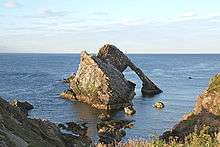

There are various smaller islets and skerries that are only exposed at lower stages of the tide in the seas surrounding the mainland of Scotland. Craiglethy is part of the Fowlsheugh nature reserve. The Three Kings, off the coast of Easter Ross near Balintore, is also known as Creag Harail or Harold's Rock and called The King's Sons in the New Statistical Account of Scotland. According to legend, three sons of a Danish prince, sailing to avenge their sister's wrongs, were wrecked here and gave these rocks their collective name. Their graves were marked by the sculptured stones of Nigg, Shandwick and Hilton of Cadboll. Another story has their burial at Nigg Rocks below the North Sutor.[57]
- Solway Firth: Inch
- North coast (from west to east): Stac an Dunain, Duslic, Stack Clò Kearvaig, An Garbh-eilean, Na Glas Leacan, Eilean Dubh, Clach Bheag na Faraid, Clach Mhòr na Faraid, Àigeach, Eilean Polsain, Boursa Island, Glas-eilean Mòr, Garbh-eilean, Wester Clett, Middle Clett, Easter Clett, Little Clett, Clett.
- East coast:
- North Moray Firth (from north to south): The Knee, Stacks of Duncansby, Stack o' Brough, South Stack, The Stacks, Eilean na h-Aibhne,[58] Three Kings.[59]
- South Moray Firth (from west to east): Covesea Skerries, Halliman Skerries, Boar's Head Rock, West Muck, East Muck, Craigenroan, Bow Fiddle Rock, Collie Rocks, Craigandargity.
- Kinnaird Head to the Bullers of Buchan: The Ron, The Skerry, Miekle Mackie, Miekle Donnon, Little Donnon, Craig Snow, Meikle Dumeath, Little Dumeath.
- Bullers of Buchan to Girdle Ness: Dunbuy, The Donnons, Skellyis of Harrol.
- Girdle Ness to Buddon Ness: Craiglethy, Craigmaroinn, May Craig.
Other than Mugdrum in the Firth of Tay and the Islands of the Forth there are no genuine islands on the east coast of Scotland south of Buddon Ness.
See also
- List of Outer Hebrides
- Inner Hebrides
- List of Orkney islands
- List of Shetland islands
- Islands of the Clyde
- Islands of the Forth
- List of islands of Scotland
- Scottish island names
- List of islands of the British Isles
- Fair Isle in Shetland, the most remote inhabited island in the United Kingdom, which lies 38 kilometres (24 mi) south-west of the Mainland.
- Foula in Shetland, which lies 22 kilometres (14 mi) west of the Mainland.
References and footnotes
- General references
- General Register Office for Scotland (28 November 2003) Scotland's Census 2001 – Occasional Paper No 10: Statistics for Inhabited Islands. Retrieved 26 February 2012.
- Fisher, James (1956) Rockall. London. Geoffrey Bles.
- Fleming, Andrew (2005) St Kilda and the Wider World: Tales of an Iconic Island. Windgather Press. ISBN 1-905119-00-3
- Haswell-Smith, Hamish. (2004) The Scottish Islands. Edinburgh. Canongate. ISBN 1-84195-454-3
- Keay, J. & Keay, J. (1994) Collins Encyclopaedia of Scotland. London. HarperCollins.
- Mac an Tàilleir, Iain (2003) Ainmean-àite/Placenames. (pdf) Pàrlamaid na h-Alba. Retrieved 26 August 2012.
- Maclean, Charles (1977) Island on the Edge of the World: the Story of St. Kilda. Edinburgh. Canongate. ISBN 0-903937-41-7
- Nicholson, Christopher. (1995) Rock Lighthouses of Britain: The End of an Era? Caithness. Whittles. ISBN 1-870325-41-9
- Ordnance Survey (2009) "Get-a-map". Retrieved 6–10 February 2010.
- Quine, David (2000) St Kilda. Grantown-on-Spey. Colin Baxter Island Guides. ISBN 1-84107-008-4
- Rackwitz, Martin (2007) Travels to Terra Incognita: The Scottish Highlands and Hebrides in Early Modern Travellers' Accounts C. 1600 to 1800. Waxmann Verlag. ISBN 978-3-8309-1699-4
- Watson, William John (1976) "Place Names of Ross and Cromarty" Ross & Cromarty Heritage Society. ISBN 978-1-4097-6657-5
- Notes
- ↑ Various other definitions are used in the Scottish context. For example, the General Register Office for Scotland define an island as "a mass of land surrounded by water, separate from the Scottish mainland" but although they include islands linked by bridges etc., this is not clear from this definition.[3] Haswell-Smith (2004) uses "an Island is a piece of land or group of pieces of land which is entirely surrounded by water at Lowest Astronomical Tide and to which there is no permanent means of dry access". This consciously excludes bridged islands, which most other sources include.[4]
- ↑ Encyclopædia Britannica (1978) says: Hebrides – group of islands of the west coast of Scotland extending in an arc between 55.35 and 58.30 N and 5.26 and 8.40 W." This includes Gigha, St Kilda and everything up to Cape Wrath – although not North Rona.
- ↑ In addition to World Heritage Status, which none of the other outlying islands share, Hirta is by far the largest individual island (Soay and Boreray are fourth and fifth largest), and at its maximum of 180 its population was by far the largest, only Stroma coming close.[6] Numerous books have been written about these islands, their history and wildlife, which at one time included three unique sub-species – two mice and the St Kilda wren.[7]
- ↑ When inhabited, these islands had strong cultural ties to the Hebrides, but they are quite distinct from the Outer Hebrides geologically and Haswell-Smith (2004) lists St Kilda in "Section 9: The Atlantic Outliers".[9]
- ↑ Possibly also known as "The Robber's Castle" and said to have been a hideout of the 12th-century pirate Sweyn Asleifsson.[16]
- ↑ There are numerous islands that are more remote from a mainland, but not from other islands. Rockall lies "the furthest distance from any other outcrop or land of any description".[18]
- ↑ Aird an Runair, North Uist NF686705 is the nearest place on an inhabited British island to Rockall approximately 367 km (228 mi) (198 nmi) away. Gob a' Ghaill, on uninhabited Soay, St Kilda and the nearest point of undisputed British soil at NA055014 is approximately 301 km (187 mi) (162 nmi) away.[23]
- ↑ Note that the Ordnance Survey maps mark the height above sea level of a high point on most islands, but in a small number of cases, this may not be the highest point.
- ↑ Indicates the presence of a lighthouse on Ordnance Survey maps.
- ↑ Indicates the last known date of permanent, year round settlement.[26]
- ↑ The Ordnance Survey indicate the remains of an 8th-century chapel, which is also the site of an 18th-century "tavern" and there is an uninhabited cottage facing the sea.[27]
- ↑ Fleming identifies a wheelhouse on the island.[30] Various tales told by the St Kildans hint at occupation in the historic period, although no concrete evidence of this has been found. There is nowhere to store a boat and any permanent residents would have been marooned there and dependent on outside assistance to leave. As a result of a smallpox outbreak on Hirta in 1724, three men and eight boys were marooned on Boreray until the following May.[31]
- ↑ The island's name means "fort" but there is only a single ruined wall of a structure said to have been built in the far-distant past by the mythical Fir Bolg.[33]
- ↑ According to the Joint Nature Conservation Committee the total land area of the Flannan Isles is 58.87 hectares (145.5 acres).[37]
- ↑ There was a population of 63 in 1891 and 30 in 1931. Uninhabited by 1951.[39]
- ↑ The name is Gaelic for "island of the house" and there is a tiny ruined structure.[36]
- ↑ There is a holiday cottage, an unmanned lighthouse and the remains of a 14th-century "Manor House".[40]
- ↑ The reef is covered by seawater at high tide and only 1.3 metres (4.3 ft) lies above water at low tides.[41]
- ↑ The lighthouse was manned from 1810 until 1988.[42]
- ↑ The nearby Innis Bheag or "Paterson Island" is now a sand spit joined to the Morrich More.[43]
- ↑ As the name implies there are two small islets separated at higher stages of the tide. The smaller islet is circa 0.25 hectares (0.62 acres).
- ↑ The Royal Commission on the Ancient and Historical Monuments of Scotland (RCAHMS) indicate the existence of a "structure" or "wall".[45]
- ↑ The Ordnance Survey indicate the presence of a ruined chapel.
- ↑ The two islands are connected to one another and the mainland at low tides and were probably inhabited at some point in the past. The Gaelic name is Eilean nan Gall meaning "islands of the strangers", which is thought to refer to their usage by Danish Vikings.[46]
- ↑ None of the very small islets are named by the Ordnance Survey.
- ↑ An area estimate of 624 square metres (6,720 sq ft). The height is circa 20 metres (66 ft).[47]
- ↑ Like nearby Boreray there is nowhere to store a boat and any permanent residents would have been marooned there and dependent on outside assistance to leave. There is a primitive hut known as Taigh Dugan (Dugan's house). This is little more than an excavated hole under a huge stone with two rude walls on the sides. The story of its creation relates to two sheep-stealing brothers from Lewis who came to St Kilda only to cause further trouble. Dugan was exiled to Soay, where he died; the other, called Fearchar Mòr, was sent to Stac an Armin, where he found life so intolerable he cast himself into the sea.[50]
- ↑ It would be impossible to maintain life for long on this precipitous crag although there are 78 storage cleitean and a small bothy used by the native St Kildan fowlers in the summer.[51]
- ↑ A figure of 124.4 hectares (307 acres) for Rona and Sula Sgeir is provided by Wood.[52] Haswell Smith gives 109 hectares (270 acres) for North Rona. Sula Sgeir is therefore c. 15.4 hectares (38 acres).[53]
- Citations
- ↑ Fleming (2005) "Men of Stone" pp. 37–59.
- ↑ Haswell-Smith (2004) p. 336.
- ↑ General Register Office for Scotland (2003) "Appendix".
- ↑ Haswell-Smith (2004) "Preface" p. xi.
- ↑ Keay & Keay (1994) p. 507.
- ↑ Haswell-Smith (2004) p. 315, 336.
- ↑ Haswell-Smith (2004) p. 318.
- ↑ "Dual World Heritage Status For Unique Scottish Islands" (14 July 2005) National Trust for Scotland. Retrieved 6 January 2007.
- ↑ Haswell-Smith (2004) pp. 313–331.
- ↑ "Corrections and clarifications". The Guardian. London. 16 April 2007. Retrieved 5 February 2009.
- ↑ Dawson, Alan (1992). Relative Hills of Britain. Cicerone Press. p. 109. ISBN 978-1-85284-068-6.
- ↑ The National Trust for Scotland has 191 m. "St Kilda – National Trust for Scotland World Heritage Site". National Trust for Scotland. Retrieved 5 February 2009.
- ↑ Rackwitz p. 347.
- ↑ See for example, Nicholson (1995) pp. 168–79.
- ↑ "Stroma, Castle Mestag" RCAHMS. Retrieved 7 September 2009.
- ↑ "Mestag Castle, Island of Stroma, Caithness" caithness.org. Retrieved 2 September 2009.
- ↑ Fisher (1956) pp. 12–13.
- ↑ Oates, John (8 April 2005) "More North Atlantic charity madness" The Register. Retrieved 8 September 2009.
- ↑ "On This Day: 21 September". BBC. 21 September 1955. Retrieved 1 August 2007.
- ↑ "House of Lords Hansard". 24 June 1997. Retrieved 1 August 2007.
- ↑ "Oral Questions to the Minister of Foreign Affairs". Dáil Éireann. 1 November 1973. Retrieved 17 January 2007.
- ↑ MacDonald, Fraser (2006). "The last outpost of Empire: Rockall and the Cold War" (pdf). Journal of Historical Geography. 32: 627–647. doi:10.1016/j.jhg.2005.10.009. Retrieved 15 May 2011.
- ↑ "2.2.1.1. Location" www.rockall.name Retrieved 30 July 2010.
- ↑ Haswell-Smith (2004) for islands >40 ha (100 acres) and Ordnance Survey maps for islands <40 ha unless otherwise stated.
- ↑ Ordnance Survey maps.
- ↑ Information is from Haswell-Smith (2004) unless otherwise stated.
- ↑ "Island prehistory" onesmallisland.org.uk. Retrieved 2 September 2009.
- ↑ A remote rock located at grid reference NX256333.
- ↑ "St Bees Head to Mull of Galloway – pilot info" ukriversguidebook.co.uk. Retrieved 19 July 2010.
- ↑ Fleming (2005) p. 58.
- ↑ Maclean (1977) pp. 48–9.
- ↑ "St Kilda" (pdf) United Nations Environment Programme World Conservation Monitoring Centre. Retrieved 4 August 2009.
- ↑ Maclean (1977) page 29.
- 1 2 3 Rick Livingstone’s Tables of the Islands of Scotland (pdf) Argyll Yacht Charters. Retrieved 12 Dec 2011.
- ↑ "Place Names in Durness" countysutherland.co.uk. Retrieved 29 November 2009.
- 1 2 Haswell-Smith (2004) p. 330.
- ↑ "SPA description:Flannan Isles". JNCC. Retrieved 5 September 2009.
- ↑ Haswell-Smith (2004) p. 331.
- ↑ Haswell-Smith (2004) p. 201.
- ↑ "A History of Auchencairn and District". www.Auchencairn.org.uk. Retrieved 29 April 2007.
- 1 2 Nicholson (1995) p. 86.
- ↑ Nicholson (1995) p. 200.
- ↑ Hansom, JD and Black, SDL (1996) "The Geomorphology of Morrich More: Management Prescription Review" (pdf) SNH. Retrieved 29 November 2009.
- ↑ "Historical perspective for Mugdrum Island". Gazetteer for Scotland. Retrieved 5 October 2008.
- ↑ "Murray's Isles" Retrieved 2 September 2009
- ↑ "Rabbit Islands" www.electricscotland.com, quoting the Ordnance Gazetteer of Scotland, which itself refers to a survey of 1880. Retrieved 30 July 2010.
- ↑ "Rockall" Full version" www.rockall.name. Retrieved 31 August 2009.
- ↑ Haswell-Smith (2004) p. 314.
- 1 2 "Rough Island" Gazetteer for Scotland. Retrieved 31 August 2009.
- ↑ See Maclean (1977) pp. 49–50 for a version of this tale.
- ↑ Quine (2000) pp. 142 and 146.
- ↑ Wood, L. J. (2007). MPA Global "Rona and Sula Sgeir" mpaglobal.org. Retrieved 8 September 2009.
- ↑ Haswell Smith (2004) p. 326.
- 1 2 See "Lighthouses" Geograph. Retrieved 4 September 2009.
- 1 2 "SPA description" JNCC. Retrieved 8 September 2009.
- 1 2 "Sailing Directions (Enroute), Pub. 141, Scotland" (pdf) National Geospatial-Intelligence Agency. p. 109. Retrieved 8 September 2009.
- ↑ Watson (1976) p. 54.
- ↑ Located at grid reference NH577954 in the inner Dornoch Firth by Carbisdale Castle.
- ↑ The Three Kings are skerries located at grid reference NH856725 and named on the 1992 revision of the Admiralty Chart "Dunrobin Point to Buckie".
